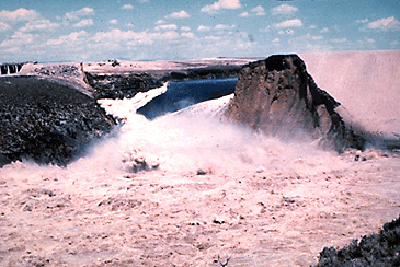SPRING 2018
FINAL EXAM
MONDAY, MAY 7, 2018, 1530-1730
Name: __________________________________ Red ID _______________________ Grade: ________
Instructions: Closed book, closed notes, closed laptop, closed cell phone. Use engineering paper. When you are finished, staple your work in sequence (1 to 5), and return this sheet with your work.
(20%) You are observing the rising flood stage of a major river in a study reach AB of length
L = 10 km. At your observation point at the downstream point B, the discharge is QB = 300 m3/s and the stage is rising at the rate of rB =3.2 mm/hr. The average surface width of the river in the study reach is W = 180 m. Estimate the present discharge at point A. How could this estimate be improved?(20%) A hydraulically wide channel is operating at Froude number F = 0.18. The unit-width discharge is q = 2.25 m2/s. What are two Langrange absolute celerities?
(20%) An irrigation canal has a mean velocity u = 0.7 m/s, mean flow depth d = 1 m, and slope
S = 0.005 m/m. Estimate the minimum time of gate opening To to minimize the possibility of a surge.(10%) Teton Dam failed on June 5, 1975, in Idaho, releasing 2,000,000 cfs. At a distance of
100 miles downstream, the flow was estimated to be 50,000 cfs. What type of wave was most likely acting? Kinematic, diffusion, or dynamic? Why?
(30%) Essay questions. Please answer the following:
In what three ways is the Seddon celerity expressed?
In what three ways if the hydraulic diffusity expressed?
In dynamic wave routing, how should the downstream boundary condition be specified to account for the loop in the rating?
Under Chezy friction, for what value of Froude number do all waves, kinematic, diffusion, mixed dynamic, and true dynamic, travel at the same celerity?
What promotes kinematic shock development? What inhibits kinematic shock development?
What is numerical diffusion? What do physical and numerical diffusion have in common?
Bonus question: Under what Courant number is the Muskingum-Cunge method likely to be more accurate? (Will replace any of the above essay questions, not add).
